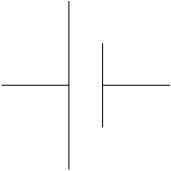
Draw circuit symbol for a) fixed resistance, b) variable resistance , c) cell, d) battery of three cells, e) an open switch and f) closed switch
Answer
507k+ views
Hint: We know that an electrical circuit is made up of different electrical components like the wires, switch and bulb to name a few. These electrical components can be denoted by simple figures called electrical circuit symbols, on a piece of paper, with the necessary property marked next to them.
Complete step-by-step solution:
An electrical component in a circuit works in a unique and specific manner. For easy understanding of how these function, they are denoted by circuit symbols in a circuit diagram in a piece of paper and are used for future references.
Given below is the circuit diagram, along with their properties.
A. Fixed resistance

The fixed resistance, also called as the resistor offers resistance to the circuit. As the name suggests, it provides a fixed or a constant resistance to the circuit, under all environments. There are different ranges of the fixed resistance available in the market.
B. Variable resistance

A variable resistance or the rheostat is used to increase or decrease the resistance provided to a circuit. This is mostly used in experiments where there is a need to study the effect of resistance on other parameters like the current and voltage for example.
C. Cell

A cell is the basic single source of energy which converts chemical energy to produce electrical energy when connected to an external circuit, which draws electricity.
D. Battery of three cells

A battery is a connection of cells, which provide a stronger electrical energy when connected to an external conducting circuit. However, for a battery to function, the cells must be connected in series, i.e. the positive terminal of one cell must be connected to the negative terminal of the next cell and so on.
E. Open switch

An open switch creates a barrier to the flowing electrons by breaking or interrupting its path. Thus making the circuit incomplete or open in other words. Hence the circuit does not conduct electricity.
F. Closed switch

As compared to an open switch, a closed switch completes the circuit, allowing the electrons to flow through it easily. Hence the circuit conducts electricity.
Note: The above given symbols are common errors often made in distinguishing the symbols. Also note that the most simple electrical circuit known is a battery connected by wires to a switch and bulb. When the switch is open, the bulb does not glow and when the switch is closed the bulb glows.
Complete step-by-step solution:
An electrical component in a circuit works in a unique and specific manner. For easy understanding of how these function, they are denoted by circuit symbols in a circuit diagram in a piece of paper and are used for future references.
Given below is the circuit diagram, along with their properties.
A. Fixed resistance

The fixed resistance, also called as the resistor offers resistance to the circuit. As the name suggests, it provides a fixed or a constant resistance to the circuit, under all environments. There are different ranges of the fixed resistance available in the market.
B. Variable resistance

A variable resistance or the rheostat is used to increase or decrease the resistance provided to a circuit. This is mostly used in experiments where there is a need to study the effect of resistance on other parameters like the current and voltage for example.
C. Cell

A cell is the basic single source of energy which converts chemical energy to produce electrical energy when connected to an external circuit, which draws electricity.
D. Battery of three cells

A battery is a connection of cells, which provide a stronger electrical energy when connected to an external conducting circuit. However, for a battery to function, the cells must be connected in series, i.e. the positive terminal of one cell must be connected to the negative terminal of the next cell and so on.
E. Open switch

An open switch creates a barrier to the flowing electrons by breaking or interrupting its path. Thus making the circuit incomplete or open in other words. Hence the circuit does not conduct electricity.
F. Closed switch

As compared to an open switch, a closed switch completes the circuit, allowing the electrons to flow through it easily. Hence the circuit conducts electricity.
Note: The above given symbols are common errors often made in distinguishing the symbols. Also note that the most simple electrical circuit known is a battery connected by wires to a switch and bulb. When the switch is open, the bulb does not glow and when the switch is closed the bulb glows.
Recently Updated Pages
A man running at a speed 5 ms is viewed in the side class 12 physics CBSE

The number of solutions in x in 02pi for which sqrt class 12 maths CBSE

State and explain Hardy Weinbergs Principle class 12 biology CBSE

Write any two methods of preparation of phenol Give class 12 chemistry CBSE

Which of the following statements is wrong a Amnion class 12 biology CBSE

Differentiate between action potential and resting class 12 biology CBSE

Trending doubts
What are the major means of transport Explain each class 12 social science CBSE

Which are the Top 10 Largest Countries of the World?

Draw a labelled sketch of the human eye class 12 physics CBSE

Explain sex determination in humans with line diag class 12 biology CBSE

Explain sex determination in humans with the help of class 12 biology CBSE

Differentiate between homogeneous and heterogeneous class 12 chemistry CBSE




